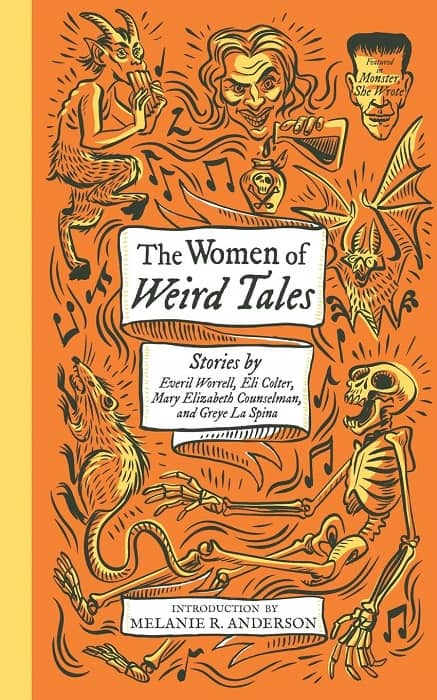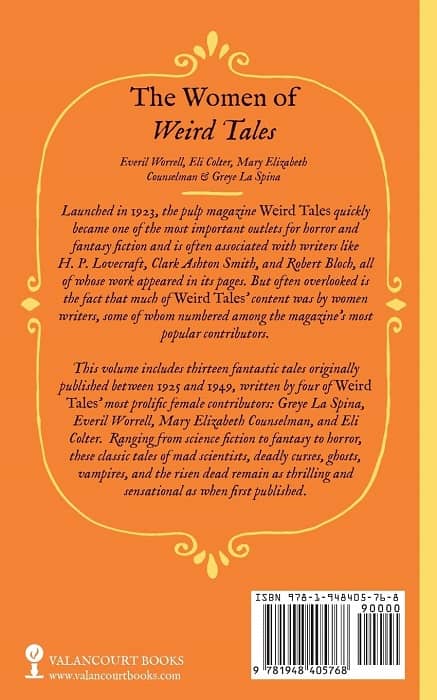Women Do It Better? The Women of Weird Tales, from Valancourt Books
 |
 |
The Women of Weird Tales
By Everil Worrell, Eli Colter, Mary Elizabeth Counselman and Greye La Spina
Introduction by Melanie Anderson
Valancourt Books (280 pages, $24.99 hardcover/$16.99 paperback/$9.99 digital, November 3, 2020)
It is well known by now that women had a pivotal role in the development of those literary genres called Gothic Fiction, Horror, Dark Fantasy, etc. If we look at the iconic Weird Tales, the golden era of which spanned the ‘20s to the ‘50s, female authors were constantly included, and they penned some of the magazine’s most popular stories. Not to mention that some of the most influential editors and cover artists of the era were women as well.
Valancourt Books has aptly published a new anthology showcasing stories from Weird Tales by female writers, Women of Weird Tales.
Greye La Spina is present with five stories. The most accomplished, to me, is “The Antimacassar,” an effective, well told tale portraying a case of vampirism, gradually disclosed throughout the yarn. Other good tales are the bizarre “The Remorse of Professor Panebianco,” in which a mad scientist designs a device to imprison the soul of dying people; “The Dead-Wagon,” a dark gothic tale about a family curse dating back to the times of the Black Death; and “ The Deadly Theory,” a disturbing piece showing how the power to bring back people from the dead leads to tragedy.
Everil Worrell’s best contributions to the volume are “Leonora,” an atmospheric, macabre piece where events take place between reality and madness; “ The Gray Killer,” a strongly horrific story taking place in a hospital ward, only partially spoiled but an unnecessary, scarcely plausible final section; and the excellent “The Canal,” a very dark, disquieting vampire tale set in a desolate area by a canal.
Eli Colter’s “ The Curse of a Song” depicts a nasty character haunting a young girl from beyond the grave. Although not quite able to maintain suspension of disbelief nor to scare the reader, the story is still pleasantly entertaining.
Among the three tales by Mary Elizabeth Counselman included, my favorite is perhaps “ The Web Silence,” an offbeat medley of SF and mystery served with a touch of humor.
All in all a very interesting anthology featuring some very good fiction, paying homage to women writers who produced excellent dark stories.
Contents:
“The Remorse of Professor Panebianco” by Greye La Spina (January 1925)
“Leonora” by Everil Worrell (January 1927)
“The Dead Wagon” by Greye La Spina (September 1927)
“The Canal” by Everil Worrell (December 1927)
“The Curse of a Song” by Eli Colter (March 1928)
“Vulture Crag” by Everil Worrell (August 1928)
“The Rays of the Moon” by Everil Worrell (September 1928)
“The Gray Killer” by Everil Worrell (November 1929)
“The Black Stone Statue” by Mary Elizabeth Counselman (December 1937)
“Web of Silence” by Mary Elizabeth Counselman (November 1939)
“The Deadly Theory” by Greye La Spina (May 1942)
“Great Pan is Here” by Greye La Spina (November 1943)
“The Antimacassar” by Greye La Spina (May 1949)
Order copies from Valancourt Books.
Mario Guslandi was born in Milan, Italy, where he currently lives. He became addicted to horror and supernatural fiction (too) many years ago, after accidentally reading a reprint anthology of stories by MR James, JS Le Fanu, Arthur Machen etc. Most likely the only Italian who regularly reads (and reviews) dark fiction in English, he has contributed over the years to various genre websites such as Horrorworld, Hellnotes, The British Fantasy Society, The Agony Column and many more. His last review for us was of Apostles of the Weird, edited by ST Joshi.